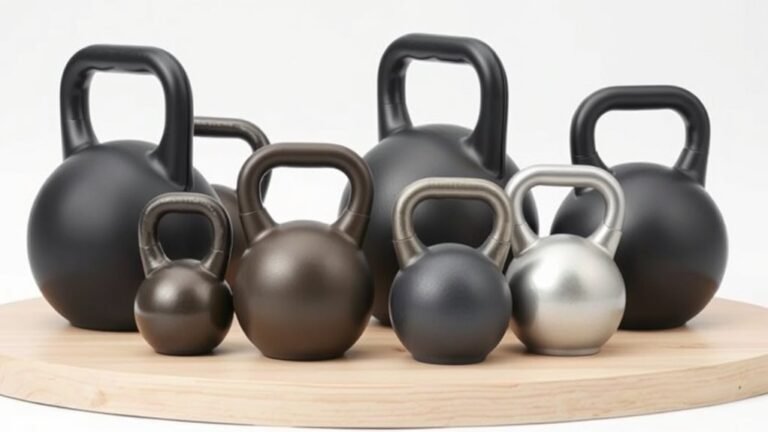10 Functional Fitness Tips for Men 40
For men over 40, focusing on functional fitness is essential. Start with core stability exercises like planks and bridges to reduce injury risk. Incorporate compound movements, such as squats and deadlifts, to engage multiple muscle groups effectively. Don't forget flexibility training; it helps with mobility and posture. Use bodyweight exercises for strength and balance. Schedule regular recovery days to allow your body to heal. Keep track of your progress and maintain a nutritious diet. Stay hydrated and incorporate low-intensity activities for better recovery. There's so much more to explore about enhancing your fitness as you age.
Key Takeaways
- Focus on compound movements like squats and deadlifts to engage multiple muscle groups and mimic daily activities.
- Incorporate core stability exercises, such as planks and bridges, to enhance balance and reduce injury risk.
- Prioritize flexibility training with regular stretching to improve mobility and posture as you age.
- Stay hydrated and maintain a balanced diet rich in lean proteins, whole foods, and healthy fats for optimal performance.
Focus on Core Stability
To build a strong foundation for your fitness, prioritize core stability in your workouts. A solid core supports your body during everyday activities and reduces the risk of injury.
Start by incorporating exercises like planks, bridges, and bird-dogs into your routine. These movements engage multiple muscle groups, enhancing balance and coordination.
Focus on maintaining proper form, as this maximizes effectiveness and safety. Don't just rely on traditional ab exercises; stability involves the entire abdominal region, including the obliques and lower back.
Gradually increase the intensity and duration of your core workouts to challenge yourself.
Incorporate Compound Movements
Why focus on compound movements? They're key to maximizing your workout efficiency and building strength in multiple muscle groups at once. Instead of isolating muscles, compound exercises engage several at a time, helping you get more out of each session. Think squats, deadlifts, and bench presses. These movements mimic everyday activities, enhancing your functional fitness.
When you incorporate compound movements into your routine, you'll not only build muscle but also improve coordination and balance. Aim to include at least two to three compound exercises in your workouts.
Start with lighter weights to master your form, and gradually increase the load as you gain strength. This approach will keep your workouts effective and engaging while preparing you for daily tasks.
Prioritize Flexibility Training

Prioritizing flexibility training is essential for maintaining mobility and preventing injuries as you age. Incorporating regular stretching can greatly enhance your overall functional fitness.
Here are four key benefits of flexibility training:
- Improved Range of Motion: Enhanced flexibility allows you to move more freely in daily activities.
- Injury Prevention: Stretching helps to keep muscles and joints healthy, reducing the risk of strains.
- Better Posture: Regular flexibility work can correct muscle imbalances and promote better alignment.
- Enhanced Recovery: Flexibility training aids in muscle recovery, helping you bounce back faster after workouts.
Make flexibility a priority in your routine, and you'll notice the positive impact on your overall strength and well-being.
Use Bodyweight Exercises
Incorporating bodyweight exercises into your fitness routine can greatly boost your strength, endurance, and overall functional movement as you age. These exercises utilize your own body weight, making them accessible and effective.
Push-ups, squats, lunges, and planks are excellent choices that can be done anywhere, anytime. You can easily modify these movements to suit your fitness level, ensuring that you challenge yourself without risking injury.
Aim for compound exercises that target multiple muscle groups, enhancing your functional capacity. Start with two to three sets of 8-12 repetitions for each exercise, gradually increasing intensity as you progress.
Consistently integrating bodyweight exercises won't only improve your physical fitness but also contribute to better mobility and stability throughout your daily life.
Emphasize Balance and Coordination

As you build strength with bodyweight exercises, don't overlook the importance of balance and coordination in maintaining functional fitness as you age.
These skills help prevent falls, improve athletic performance, and enhance daily activities.
Here are four effective ways to emphasize balance and coordination:
- Single-Leg Stands: Practice standing on one leg for 30 seconds to improve stability.
- Heel-to-Toe Walks: Walk in a straight line, placing one foot directly in front of the other to sharpen focus and balance.
- Balance Boards: Use a balance board or stability disc to challenge your core stability.
- Yoga or Tai Chi: Incorporate these practices into your routine to enhance flexibility and coordination.
Implement Functional Equipment
Using functional equipment can greatly enhance your strength, stability, and overall performance in daily activities. Incorporating tools like kettlebells, resistance bands, and medicine balls into your routine lets you engage multiple muscle groups and mimic real-world movements.
For instance, kettlebell swings boost your core stability while improving cardiovascular health. Resistance bands add versatility, allowing for various exercises that target your arms, legs, and back. Medicine balls are excellent for dynamic workouts, helping to develop explosive power.
Start with basic movements and gradually increase complexity as you become comfortable. Focus on form to prevent injuries and maximize benefits.
Schedule Regular Recovery

Scheduling regular recovery is essential for maintaining your performance and preventing burnout in your fitness routine. Recovery isn't just about taking a break; it's a vital part of your growth and longevity in fitness.
Here are some effective recovery strategies you should consider:
- Rest Days: Include at least one full rest day each week to allow your body to heal.
- Active Recovery: Engage in low-intensity activities like walking or yoga on off days to promote blood flow.
- Sleep: Aim for 7-9 hours of quality sleep each night to support muscle repair.
- Hydration and Nutrition: Stay hydrated and consume a balanced diet rich in protein and nutrients to fuel recovery.
Implementing these practices will keep you feeling strong and capable as you age.
Track Progress Consistently
While recovery plays a key role in your fitness journey, tracking your progress consistently is equally important for achieving long-term results. By monitoring your workouts, you'll identify what works and what doesn't, helping you optimize your routine. Here's a simple way to track your progress:
| Week | Workout Type |
|---|---|
| Week 1 | Strength Training |
| Week 2 | Cardio |
| Week 3 | Flexibility & Mobility |
| Week 4 | Functional Movements |
| Week 5 | Active Recovery |
Consider keeping a journal or using apps to log your exercises, weights, and reps. This way, you'll stay motivated and accountable, making adjustments when necessary to keep pushing toward your fitness goals.
Maintain Proper Nutrition

Maintaining proper nutrition is essential for men over 40 to support their fitness goals and overall health. As you age, your body requires a balanced diet to fuel your workouts and recovery.
Here are four key nutrition tips to evaluate:
- Prioritize Protein: Incorporate lean protein sources like chicken, fish, and legumes to maintain muscle mass.
- Focus on Whole Foods: Choose fruits, vegetables, whole grains, and healthy fats to provide essential nutrients.
- Limit Processed Foods: Reduce intake of sugar and unhealthy fats to promote better health.
- Adjust Portion Sizes: Be mindful of portion control to avoid overeating and maintain a healthy weight.
Stay Hydrated and Active
Proper nutrition sets the foundation, but staying hydrated and active is equally important for men over 40 to enhance performance and overall well-being.
Drinking water consistently throughout the day keeps your body functioning efficiently, aids digestion, and boosts energy levels. Aim for at least 8 cups daily, adjusting for activity levels and climate.
Incorporate physical activity into your routine by engaging in a mix of strength training, cardio, and flexibility exercises. This combination not only combats age-related muscle loss but also maintains joint health.
Find activities you enjoy, whether it's hiking, cycling, or swimming, to make staying active more enjoyable.
Questions
How Can I Assess My Current Fitness Level Effectively?
To assess your current fitness level effectively, try performing a mix of strength, endurance, and flexibility tests. Track your performance, note any limitations, and compare results over time to measure your progress accurately.
What Are the Best Warm-Up Exercises Before Workouts?
Before workouts, you've gotta incorporate dynamic stretches like arm circles, leg swings, and lunges. These warm-up exercises increase blood flow, enhance flexibility, and prepare your body for the intensity ahead, reducing injury risks.
How Often Should I Change My Workout Routine?
Think of your workout routine like a favorite song; if you play it on repeat, it loses its charm. Change your routine every 4-6 weeks to keep things fresh and your body challenged.
Are There Specific Exercises for Joint Health?
Yes, there are specific exercises for joint health. You should focus on low-impact movements like swimming or cycling, incorporate flexibility training, and strengthen surrounding muscles with resistance exercises to support your joints effectively.
How Can I Stay Motivated to Stick to My Fitness Plan?
Did you know that 80% of people abandon their fitness plans within three months? To stay motivated, set clear goals, track your progress, find a workout buddy, and celebrate your achievements. You've got this!
Conclusion
Incorporating these functional fitness tips can help you stay strong and active as you age.
Remember, 'an ounce of prevention is worth a pound of cure.'
By focusing on core stability, flexibility, and proper nutrition, you can not only enhance your performance but also reduce the risk of injury.
Stay committed to tracking your progress and embracing recovery.
With the right approach, you can enjoy a fulfilling, active lifestyle well into your 40s and beyond.







